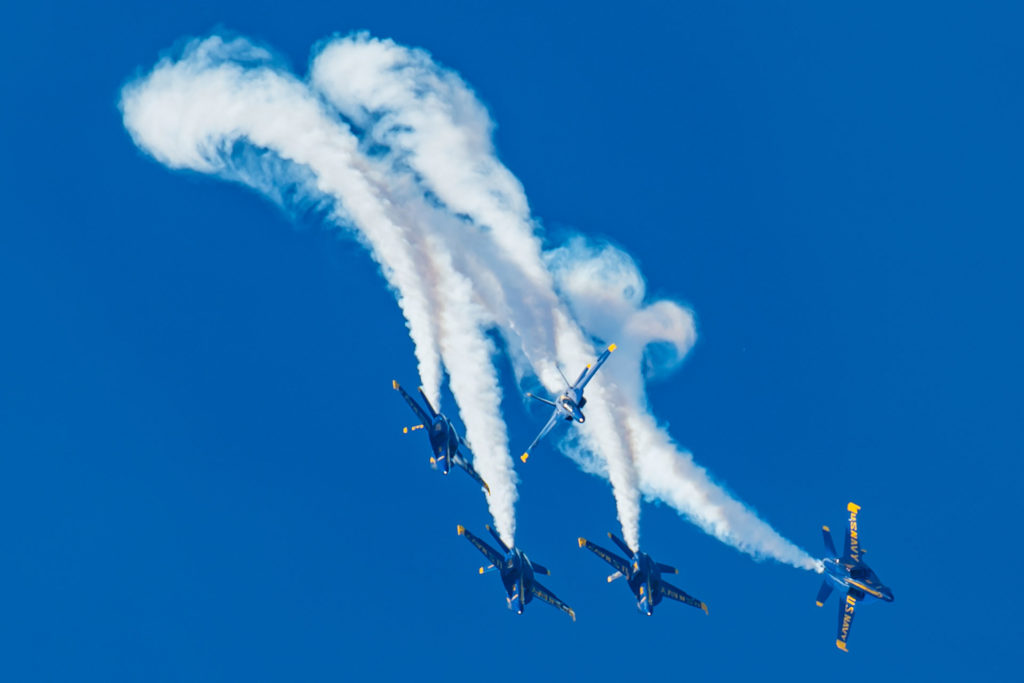Estimated reading time 7 minutes, 9 seconds.
Brian C. Kesselring is commanding officer and flight leader of the U.S. Navy Blue Angels. Prior to joining the Blue Angels in September 2019, Brian served as commanding officer of the “Sunliners” of VFA-81. Today, he has accumulated more than 4,300 flight hours and has 812 carrier-arrested landings. His decorations include the Meritorious Service Medal, six Strike/Flight Air Medals, three Navy and Marine Corps Commendation Medals, two Navy and Marine Corps Achievement Medals, and various personal, unit, and service awards.
Skies had the opportunity to talk with Brian about his experience with the Blue Angels, the team’s demonstration, and more. See his answers below!

Skies: How long have you commanded the U.S. Navy Blue Angels?
Brian Kesselring: This is my second year. I took command from Capt Eric Doyle in the fall of 2019.
Skies: What were the challenges transitioning from the F-18C Hornet to the F-18E/F Super Hornet?
B.K.: In formation, the Super Hornet has a different airflow. So we froze the team in 2020 — partly due to the transition — to make sure we had time to figure out the new airframe. We found that some of the mechanics that were required were slightly different, as the Super Hornet pushes a lot more air in different spots of the formation. Frankly, it has a bigger wing and stabilizer, so we had to make sure the formation still worked. It is a totally different airframe despite looking like the Hornet. All the internals are new, like the flight control systems, hydraulics, and more power. With the different wing and leading-edge extensions, it is like comparing a 30-year-old car to a new car.

Skies: Do you fly farther apart now?
B.K.: It’s about the same, but we fly in different spots to maintain the 18 inches from canopy to wingtip separation. Because it is a 33 percent larger airframe, it appears to the crowd we are flying closer, but we keep the same safety margins as in the Hornet. When I first joined the team, I was surprised as a naval aviator about the precision I witnessed as a backseater; I was introduced to all the positions as I was getting worked up to flight leader. It was impressive to me as a fleet aviator, and I hope it is as impressive to the crowd.
Skies: What are the challenges of leading a large formation?
B.K.: Flying six aircraft as one is a challenge to get everyone synced up. It takes a lot of practice. We spend an inordinate amount of time getting to know each other. That starts at the end of our previous season and moves into our winter training and next season.
Skies: Is there a lot of radio chatter during a performance?
B.K.: We are in our 75th year of flying the Blue Angels team, and looking back you can see how the cadence has evolved — the tone and volume of different calls. I talk quite a bit over a 40-minute show. I’m constantly giving calls to the wingmen to let them know when I’m doing something and how I’m doing it — if I’m adding another percent of power, or cutting a percent of power at different times.

Skies: How does weather affect a Blue Angels display?
B.K.: We will fly minimum VFR, so if it is at minimums, we will fly what we call a “flat show.” We make modifications to the demonstration to flatten everything out. We have five separate shows that we can do based on visibility, ceilings, and other weather conditions.
Skies: With flying the Super Hornet, is the demonstration longer or shorter?
B.K.: It is relatively the same… I’d say it is a little shorter, and as we progress through the year as the team gains more experience, we can cut down some of the time between maneuvers.
This interview has been edited for clarity.









Just saw the practice show at NAS JAX yesterday. A superior show in all respects. I was in Naval Aviation for over 26 years and am curious as to whether the CO’s father was a Naval Aviator as well.
Brian I would love to meet you before you leave. I work at Goodyear in Rockmart Ga. I made fuel tanks for f14, and f16 fuel tanks.